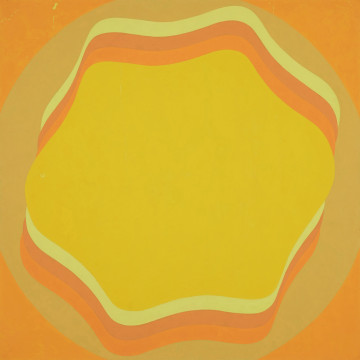
Painting
1969
National Museum in Szczecin
Part of the collection: Post-avant-garde and progressive art
The works in the Wstęgi (1969) series, painted by Janos Fajó with utmost attention to detail, in pure, vibrant colors, evoke associations with the trends of optical art, minimalism and new geometry. The artist's original style, which he developed in the 1960s, is based on the tradition of constructivism and geometric abstraction. The fundamental elements of his works include basic forms (circle, triangle, square) and colours (yellow, blue, red), which the artist creates by simplification, reducing shapes observed in nature to geometric forms and their variables. At the same time Fajó used exceptionally rich colour palette. A typical element of his works are streamlined shapes, but also large, regular areas of pure colour. His paintings, graphics and sculptures feature symmetry, asymmetry, as well as variations in movement, rhythm and dynamism. Fajó is one of the most important contemporary Hungarian artists. He developed various concepts pursued by his teachers and mentors – Lajos Kassák , a leading figure of the Hungarian avant-garde, Max Bill, representative of the rational concrete art, and Victor Vassarely, founder of the optical art trend. At the Budapest Studio (Pesti Műhely), founded in 1973, Fajó collaborated with other artists from the geometric abstraction milieu, including Imre Bak, István Nádler, Tamás Hencze, and Ilona Keserü. Together with those artists, he actively participated in the development of the neo-avant-garde movement in Hungary from the 1970s to the 1990s. He was also involved in publishing, exhibitions, education and art theory.
Marlena Chybowska-Butler
Author / creator
Dimensions
cały obiekt: height: 51 mm, width: 50 mm
Object type
painting
Creation time / dating
Creation / finding place
Identification number
Location / status

1969
National Museum in Szczecin

1969
National Museum in Szczecin

1969
National Museum in Szczecin
DISCOVER this TOPIC
Museum of King Jan III's Palace at Wilanów
DISCOVER this PATH
Educational path